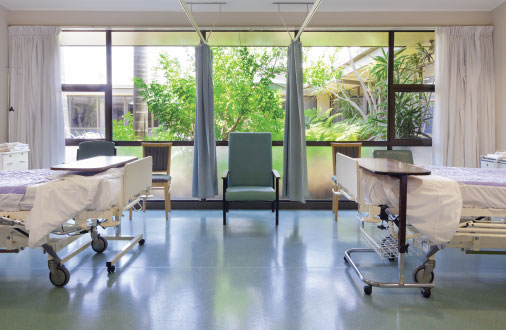Welfare Denmark is addressing the health care challenges—rising costs and aging populations—that municipalities around the world face. It developed Virtual Rehabilitation, an interactive platform based on Kinect for Windows, which supports movement, voice, and gesture recognition. Physiotherapists use Microsoft Lync 2010 as they engage and communicate with patients from a distance while the patients do physical therapy exercise programs in their homes. By using Virtual Rehabilitation, municipalities can reduce costs, improve options for health care, and enhance patient outcomes.
Summary
The Danish Technological Institute asked Welfare Denmark—a company that develops innovative welfare technology products—to create an interactive platform that citizens could use to perform rehabilitative exercises at home, at work, or in community centers. Welfare Denmark built Virtual Rehabilitation, a standalone device based on Kinect for Windows and Microsoft Lync 2010 that guides patients through rehabilitation exercises. Physiotherapists can monitor patients’ movements, track the quality of their exercises, and see whether they have completed the therapies.
”This generation of elderly people are not interested in going to elderly homes,” says Ulrik Møll, Managing Director of Welfare Denmark. ”We can help them remain at home and rehabilitate in a modern way through this solution.”
Each patient receives a Kinect device, which includes a camera and a depth sensor that can read body language. The setup also includes a touch screen with a SIM card that uploads encrypted data through the mobile network. The solution uses Microsoft Lync 2010 and Skype federation so patients can communicate with physiotherapists. “Citizens feel as if they’re being guided by professionals,” says Arne Nicolajsen, Director of Healthcare, Esbjerg Municipality. “They feel secure that they are performing the exercises correctly in their own homes.”
Esbjerg, Denmark, was first municipality to adopt Virtual Rehabilitation. Another 20 Danish municipalities have bought the solution, and countries across the globe are making inquiries. “This is the first time we have been able to prove that telemedicine solutions can lead to the prevention of people getting sick or rehospitalized,” says Møll. “I don’t doubt for one second that you will see all countries in the world using Kinect for rehabilitating people in their homes.”
The Full Story
Technology in Public Health Solutions 
Located in Esbjerg, Denmark, Welfare Denmark is involved in a number of public and private partnerships to develop innovative welfare technology solutions that are geared toward the highest usability for patients. The company has aligned its goals with Danish local authorities to ensure that patients can use technology solutions to manage their health issues in their own homes.
“Welfare Denmark is based on the legal rights of citizens to access healthcare,” says Ulrik Møll, Managing Director of Welfare Denmark. “We make interactive technologies and work with Danish municipalities and the Danish Technological Institute, a nonprofit organization that advises Danish municipalities on health IT solutions that address tough economic challenges.”
A Virtual Physiotherapist in the Home
The Danish Technological Institute asked Welfare Denmark to create an interactive platform that would enable citizens to perform rehabilitative exercises at home. In collaboration with scientists and physiotherapists, Welfare Denmark built Virtual Rehabilitation, a device based on Kinect for Windows that works with Microsoft Lync 2010 and Skype federation. It includes software that guides patients through rehabilitation exercises, monitors and corrects their movements in real time, and makes it possible for health care practitioners to see whether patients have completed the therapies.
”This generation of elderly people are not interested in going to elderly homes,” says Møll. ”We can help them remain at home and rehabilitate in a modern way through this solution.”
 Launched in April 2012, Virtual Rehabilitation supports movement, voice, and gesture recognition, which makes it possible to track patients’ movements as they go through a program. A physical therapy program can involve a subset of 130 exercises for the hips, shoulders, knees, and back. Other programs address lung and heart disorders, rheumatism, blood circulation, and the four major muscle groups.
Launched in April 2012, Virtual Rehabilitation supports movement, voice, and gesture recognition, which makes it possible to track patients’ movements as they go through a program. A physical therapy program can involve a subset of 130 exercises for the hips, shoulders, knees, and back. Other programs address lung and heart disorders, rheumatism, blood circulation, and the four major muscle groups.
Each patient gets a Kinect camera that includes a depth sensor that can read human body language. A Hewlett Packard touch screen with a SIM card uploads encrypted data through the mobile network. The solution takes advantage of Microsoft Lync 2010 and a multi-array microphone so patients can use instant messaging or videoconferencing to communicate with physiotherapists. “Citizens feel as if they’re being guided by professionals,” says Arne Nicolajsen, Director of Healthcare, Esbjerg Municipality. “They feel secure that they are performing the exercises correctly in their homes.”
To date, 20 Danish municipalities have bought Virtual Rehabilitation, and countries across the globe are making inquiries with Welfare Denmark. “This is the first time we have been able to prove that telemedicine solutions can lead to the prevention of people getting sick or rehospitalized,” says Møll. “There are no other commercially available solutions of this type that use Kinect anywhere else in the world. We are now in the phase of making business cases for other health conditions.”
Citizens feel as if they’re being guided by professionals. They feel secure that they are performing the exercises correctly in their homes.
Getting Stronger All the Time
Municipalities and citizens benefit from the Virtual Rehabilitation solution from Welfare Denmark by enhancing patient outcomes, reducing costs, and improving options for health care.
Improves Outcomes
With Virtual Rehabilitation, physiotherapists can treat patients remotely for a variety of health issues, and can still monitor and confirm whether patients have correctly completed their rehabilitation exercises. “If a patient is not performing an exercise correctly, the therapist can see it, contact them, make corrections, and better help them complete their rehabilitation,” says Søren Stenger, Physiotherapist at Esbjerg Rehabilitation Center.

One patient went home from the hospital and was unable to climb the stairs to his bedroom. After using the training module, he said, “Now I have no problems climbing up or down stairs. I was surprised that I made such fast progress. I get stronger all the time.”
 Today the solution is used for elder care, but the technology can be used to treat occupational and other injuries or to provide proactive care or training. Health providers can upload relevant information to the system, further enhancing the system’s value in terms of refining treatment modalities.
Today the solution is used for elder care, but the technology can be used to treat occupational and other injuries or to provide proactive care or training. Health providers can upload relevant information to the system, further enhancing the system’s value in terms of refining treatment modalities.
Saves Costs
In an early case at Esbjerg, a 73-year old man successfully used the solution and, over a three-month period, the municipality saved nearly US$2,500. Without Virtual Rehabilitation, the cost to the municipality, which pays for patient care, would have been $1,955 for two home visits per month by referred therapists, and $1,400 for five days at a rehabilitation center—a total of $3,355. With Virtual Rehabilitation, the total cost of licenses plus two online consultations per month with referred therapists was $898, a savings of $2,457.
“We have been able to overcome health care’s rising costs because Kinect is available at a low price and features fantastic functionality,” says Møll. “I don’t doubt for one second that you will see all countries in the world using Kinect for rehabilitating people in their own homes.”
Enhances Access to Health Care
Statistics Denmark, a Danish governmental organization, estimates that in five years, there will be 20 percent more elderly people in Denmark to care for. Welfare Denmark is just one organization that’s working to overcome health care’s biggest global challenges, from rising costs to services inequalities. “We can’t wait five years,” says Møll. “We have to act now—around the world. Health care challenges are a huge issue. It’s not an option whether we have to offer virtual rehabilitation. It’s a must.”
We have been able to overcome health care’s rising costs because Kinect is available at a low price and features fantastic functionality. I don’t doubt for one second that you will see all countries in the world using Kinect for rehabilitating people in their own homes.






















